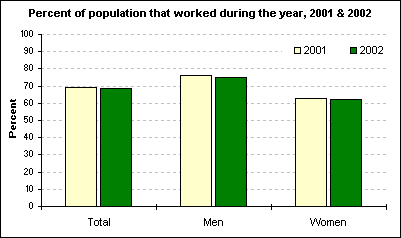Percent of men and women that worked during 2002
December 23, 2003
In 2002, the proportion of the civilian noninstitutional population 16 years old and over that worked at some point during the year was 68.4 percent, 0.9 percentage point below its 2001 level of 69.3 percent.

[Chart data—TXT]
In contrast, from 1986 through 2001, the proportion with work experience had remained at or above 69.0 percent, peaking at 70.6 percent in 1999.
The proportion of men 16 years old and over that worked at some point during 2002 was 75.1 percent, down from 76.1 percent the year before. The proportion of women who worked sometime during the year was 62.3 percent, down from 63.0 percent.
Among those with work experience during 2002, 76.0 percent were employed year round (either full or part time), essentially the same as in 2001. Continuing a long-term growth trend, full-year employment among women increased to 73.0 percent from 72.3 percent in 2001.
These data come from the Annual Social and Economic Supplement to the Current Population Survey, a monthly survey of households conducted by the U.S. Census Bureau for the Bureau of Labor Statistics. For additional information, see "Work Experience of the Population in 2002" (PDF) (TXT), news release USDL 03-911. Work experience data for 2002, which were collected in the 2003 Annual Social and Economic Supplement, are not strictly comparable with data for 2001 and earlier years because of the introduction in January 2003 of revised population controls.
OF INTEREST
Recent editions of Spotlight on Statistics
- Fatal Injuries to Foreign-Born Hispanic or Latino Workers
Explores the industries, occupations, and events related to these fatalities.
- For-Profit, Nonprofit, and Government Sector Jobs in 2022
Compares the labor force characteristics and experiences of workers in the for-profit, nonprofit, government, and self-employed sectors.
- Union Membership, Activity, and Compensation in 2022
Focuses on trends in union membership, work stoppages, and pay and benefits among union members.
- A Look at a Neat Industry: Distilleries
Examines trends in employment, establishments, wages, and consumer prices for distilleries.
- Healthcare Occupations: Characteristics of the Employed
Compares the demographic characteristics of workers in healthcare occupations.